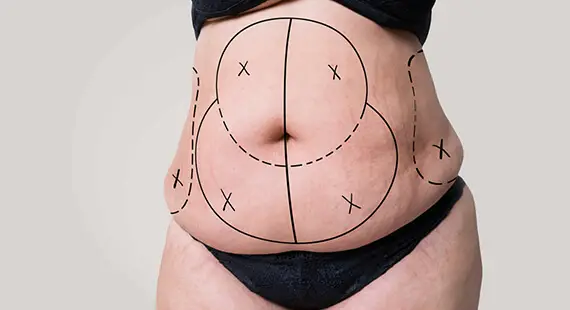Tummy tuck surgery or abdominoplasty is a popular cosmetic surgery targeting the excess fat and skin on a patient’s abdomen. The procedure is also known as lipoabdominoplasty since it combines fat removal with excess skin excision. With the help of advanced technology and sophisticated techniques, board-certified plastic surgeons achieve very natural-looking results that follow the contours of your abdominal muscles.
The first step in lipoabdominoplasty is fat removal. Using state-of-the-art, minimally invasive MicroAire and VASER technology, your plastic surgeon can accurately target and suction out any excessive subcutaneous fat. VASER technology additionally produces heat which tightens the skin without needing extra excision.
However, unlike the liposuction surgery procedure, abdominoplasties include excess skin removal, too. Techniques for skin excision have also significantly evolved. Using horizontal and vertical muscle plication along the muscles’ natural hills and valleys can improve the toned look and contribute to 6-pack abs. Additionally, drawing the lateral flaps of skin and suturing them progressively (hi-lateral tension abdominoplasty) helps distribute the tension evenly across the abdomen.
Equal distribution ensures a more comfortable recovery period. During the procedure, your surgeon may also reposition your navel so that it is not too high or low after the skin excision.
All these measures constitute a full tummy tuck. So, what is a mini tummy tuck?

Differences Between a Full and Mini Tummy Tuck Surgery
The main differences between a mini and full tummy tuck lie in scarring and the navel repositioning.
A mini tummy tuck is used by patients with a paunch in the lower abdomen. Thus, like a full tummy tuck, a mini tummy tuck also involves skin excision. However the incision is smaller since the amount of skin that needs removal is also less.
This brings us to the difference between patients for full and mini tummy tuck. In a full tummy tuck, the patient’s skin has lost a large amount of elasticity. It is much more lax and there is usually a lot of hanging skin that needs to be removed. In a mini tummy tuck, while skin excision is still necessary, there is minimal laxity. However, it does not have enough elasticity to be tightened with a minimally-invasive device like VASER or Radiofrequency.
First excess fat is removed by circumferential liposuction. For excision, your surgeon makes a low incision that is smaller than the full tummy tuck’s incision. The flap is then lifted below the navel or belly button. The abdominal muscles may also be tightened with horizontal sutures. There is no vertical plication in a mini tummy tuck.
Finally, in a full tummy tuck, your navel is repositioned for the most aesthetic result. In a mini tummy tuck, your navel is not repositioned. Due to the more contained nature of the procedure, the navel is only pulled down a little when the flap is closed, making repositioning unnecessary.
As a leading plastic surgeon in Gurgaon, Dr Priya Bansal at RG Aesthetics understands the needs of her patients and caters to them. She ensures natural-looking results and smooth recoveries for all her tummy tuck patients with advanced technology and sophisticated techniques!







